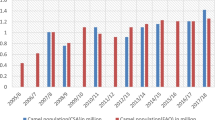Abstract
Despite its importance in Mali’s economy, camel breeding in the country remains poorly documented, impeding effective policy-making in this regard. This study consisted in a 3-month survey and aimed at characterising camel breeding systems in Ansongo, in the region of Gao, Mali. It highlights the diversity of strategies adopted by breeders and their evolutions. Supplementary feeding and veterinary care were seldom practised. In zones close to the Niger River, cattle were substituted to camels. Transhumance routes also are modified but mobility keeps its vital role in the breeding system. Important differences within the study region in the classification of camel breeds have been reported that will influence the implementation of a collective action for animal genetic improvement. The improvement goals should take the actual management, including mobility and the mixed nature of the herds into account.

Similar content being viewed by others
References
Abdallah, H. R., Faye, B., 2013. Typology of camel farming system in Saudi Arabia. Emirate, Journal Food Agricultural, 25, 250–260.
Antoine-Moussiaux, N., Faye, B., Vias, G., 2005. Tuareg ethnodiagnostic skill of camel diseases in Agadez area (Niger), Journal of Camel Practice and Research, 12, 85–93.
Antoine-Moussiaux, N., Faye, B., Vias, G., 2007. Tuareg ethnoveterinary treatments of camel diseases in Agadez area (Niger), Tropical Animal Health Production, 39, 83–89.
Aujla, K.M., Jasra, A.W., Munir, M., 1998. Socio-economic Profile of Camel Herders in South-Western Mountainous Areas of Pakistan. Proceedings of the third Animal Production under Arid Conditions, vol. 2, 154–174.
Bénard, C., Faye, B., Moulin, C.H., Kölher-Rollefson, I., 2008. A typology of the camel keepers in the Jaisalmer district, Rajasthan, India, Journal of Camel Practice and Research, 15, 231–238.
Chaibou, M., 2005. Productivité zootechnique du désert: le cas du bassin laitier d’Agadez au Niger (Thèse de doctorat). Montpellier II France, 310p. http://camelides.cirad.fr/fr/science/pdf/these_chaibou.pdf
Chaibou, M., Faye, B., 2005. Fonctionnement des élevages camelins de la zone périurbaine de d’Agadez au Niger: enquête typologique, Revue d’élevage et de médecine vétérinaire des pays tropicaux, 4, 273–283.
Faye, B., 2003. Performances et productivités laitières de la chamelle: les données de la littérature. Séminaire international sur le lait de chamelle, Niamey, Niger, 4–6 novembre 2003. FAO-CIRAD-ONG Karkara. 12p.
Faye, B., Chaibou, M., Vias, G., 2012. Integrated impact of climate change and socioeconomic development on the evolution of camel farming systems. British Journal Environement Climat Change, 2, 227–244.
Homann, S., Rischkowsky, B., Steinbach, J., Kirk, M., Mathias, E., 2008. Towards Endogenous Livestock Development: Borana Pastoralists’ Responses to Environmental and Institutional Changes, Human Ecology, 36, 503–520 .
Kaufmann, B. A., 2005. Reproductive performance of camels (Camelus dromedarius) under pastoral management and its influence on herd development, Livestock Production Science, 92, 17–29.
Laval, G., Khanna, N.D., Faye, B., 1998. A typology of camel farming systems in Rajasthan. Revue Elevage Médecine Vétérinaire en Pays Tropicaux, 51, 147–152.
Lê, S., Josse, J., Husson, F., 2008. FactoMineR: An R Package for Multivariate Analysis. Journal of Statistical Software, 25 (1), url : http://www.jstatsoft.org/v25/i01
Lhoste, P., 2007. Sociétés pastorales et désertification au Sahel, Bois et forêts des tropiques, 293, 49–59. http://bft.cirad.fr/cd/BFT_293_49-59.pdf
Mburu, D.N., Ochieng, J.W., Jianlin, H., Kaufmann, B., Reger, O., 2003. Genetic Diversity of Indigenious Kenyan Camel Populations; Implication for their Classification, Animal Genetics, 34, 26–32.
Michel, J.F., Bengoumi, M., Bonnet, P., Hidane, K., Zro, K,, Faye, B., 1997. Typologie des systèmes de production camélins dans la province de Laâyoune -Maroc. Revue Elevage Médecine Vétérinaire en Pays Tropicaux, 50, 313–323.
Mukasa–Mugerwa, E., 1985. Le chameau (Camelus dromaderius): Etude Bibliographique. CIPEA, Monographie 5, 111 p.
National Institute of Statistic, 2011. 4ème Recensement Général de la Population et de l’Habitat du Mali (RGPH): Résultats Définitifs. Bureau Central du Recensement - BCR BP, 12 - Bamako (Mali), Novembre 2011.
Ouologuem, B., Moussa, M., Coulibaly, M.D., N’Diaye, M., 2004. Etude et amélioration du système d’élevage camelin, Rapport final de recherche, 10e session Comité de Programme, IER, 45 p.
Raziq, A., Verdier, K.D., Younas, M., 2010. Ethno veterinary treatments by dromedarius camel herders in the Suleiman Mountainous Regions in Pakistan: an observation and questionnaire study, Journal of Ethnobiology and Ethnomedicine, 6–16.
Regional Direction of Veterinary Service of Gao, 2008. Rapport annuel d’activités.
Retaillé, D., 2003. Le destin du pastoralisme nomade en Afrique. In: L’information géographique. 67-1-88-102. http://www.persee.fr/web/revues/home/prescript/article/ingeo_0020-0093_2003_hos_67_1_2857
Saidu, A., 1986. Contribution à l’étude d’un système pastoral sahélien: la transhumance au Niger: ses aspects, son incidence et les perspectives d’avenir. Thèse Doctorat Vétérinaire, Université de Dakar, Sénégal, 120p.
Simianer, H., 2005. Decision making in livestock conservation, Ecological Economics, 53, 559–572.
Soini, K., Diaz, C., Gandini, G., De Haas, Y., Lilja, T., Martin-Collado, D., Pizzi, F., Hiemstra, S.J., Developing a typology for local cattle breed farmers in Europe. Journal of Animal Breeding and Genetics, 2012, 129, 436–47.
Van Den Bossche, P., Thys, E., Elyn, R., Marcotty, T., Geerts, S., 2004. The provision of animal health care to smallholders in Africa: an analytical approach, Revue Scientifique et Technique de l’OIE, 23, 851–861.
Volpato, G., Di Nardo, A., Rossi D., Lamin Saleh, S.M., Boglia, A., 2013. “Everybody knows”, but the rest of world: the case of caterpillar-borne reproductive loss syndrome in dromedary camels observed by Sahrawi pastoralists of Western Sahara. Journal of Ethnobiology and Ethnomedicine, 9–5.
Conflict of interest
The authors declare that they have no conflict of interest.
Author information
Authors and Affiliations
Corresponding author
Rights and permissions
About this article
Cite this article
Traoré, B., Moula, N., Toure, A. et al. Characterisation of camel breeding practices in the Ansongo Region, Mali. Trop Anim Health Prod 46, 1303–1312 (2014). https://doi.org/10.1007/s11250-014-0644-z
Accepted:
Published:
Issue Date:
DOI: https://doi.org/10.1007/s11250-014-0644-z




